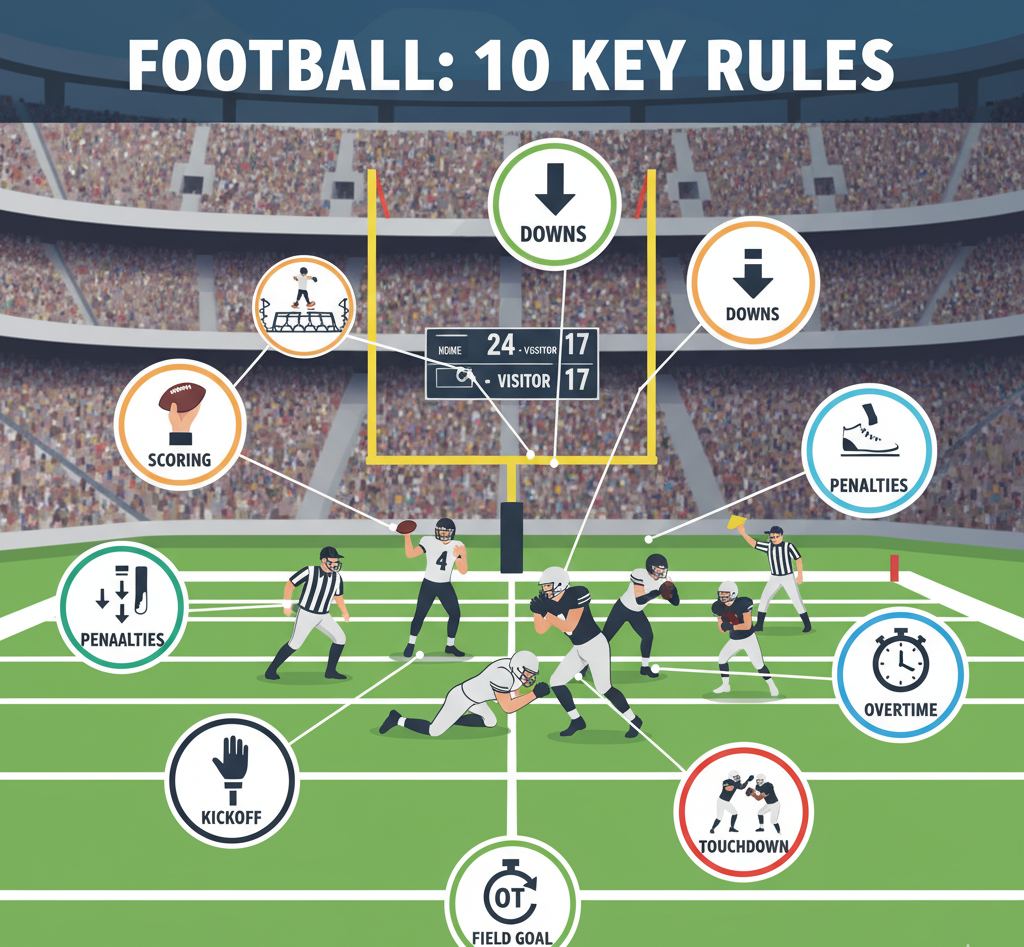Football is one of the most popular sports in the world, attracting millions of fans and players from every corner of the globe. From Friday night lights in high school stadiums to professional NFL matchups and international soccer tournaments, football in its different forms remains a symbol of competition, teamwork, and passion.
For new fans, however, the game can feel complicated with its many terms, penalties, and strategies. To simplify things, let’s break it down into 10 essential rules about football that every player, coach, or fan should understand.
1. The Objective of the Game
At its core, football is about scoring more points than your opponent. In American football, teams try to advance the ball into the opposing team’s end zone for touchdowns, or they kick the ball through the uprights for field goals. In association football (soccer), the main objective is to score by getting the ball into the opponent’s net.
While the formats differ, both share a simple truth: the team with the most points (or goals) at the end of regulation wins.
2. Team Composition and Player Roles
A football team is made up of specialized players. In American football, each side has 11 players on the field at a time, divided into offense, defense, and special teams. Positions include quarterbacks, linemen, receivers, running backs, linebackers, and defensive backs.
In soccer, there are also 11 players per team, but roles differ: goalkeeper, defenders, midfielders, and forwards. Understanding these roles is crucial to appreciating the strategies that shape the game.
3. Starting the Game and Kickoffs
Every football game begins with a kickoff. The ball is placed on a tee, and one team kicks it to the other to start play. Kickoffs also occur after scores and at the beginning of the second half.
This rule ensures fairness, giving both teams the opportunity to control the ball and demonstrate their strategy from the very start.
4. Advancing the Ball
In American football, the offense must move the ball down the field in a series of downs. They have four tries (downs) to advance the ball 10 yards. If successful, they earn another set of downs. If not, possession is turned over.
In soccer, the ball must be moved using players’ feet, heads, or bodies (except hands and arms, unless you’re the goalkeeper). Teams advance by passing, dribbling, or shooting.
Both forms of football emphasize ball control and field positioning as keys to success.
5. Scoring Rules
Scoring is what excites fans the most. In American football:
Touchdown: 6 points (ball carried or caught in end zone)
Extra Point/Two-Point Conversion: 1 or 2 points after touchdown
Field Goal: 3 points (ball kicked through uprights)
Safety: 2 points (defense tackles offense in its own end zone)
In soccer:
Goal: 1 point when the ball crosses the opponent’s goal line within the frame of the net
The variety of scoring methods in American football makes strategy more complex, while the simplicity of soccer’s goal system adds to its global accessibility.
6. The Rules of Downs and Time
Time management is one of the most critical rules. American football is divided into four quarters, usually 15 minutes each at the professional level. Teams must be efficient with their downs to keep drives alive and maximize scoring opportunities.
In soccer, games consist of two 45-minute halves with stoppage time added at the referee’s discretion. There are no downs, which creates continuous play and flow.
7. Fouls and Penalties
Penalties keep football fair and safe. In American football, common penalties include:
Offside: Player crosses line of scrimmage too early
Holding: Illegally grabbing an opponent
Pass Interference: Preventing a receiver from catching the ball
Unsportsmanlike Conduct: Behavior that breaks sportsmanship rules
In soccer, fouls include tripping, pushing, handball, or dangerous play. Yellow and red cards are issued to penalize or eject players.
These rules maintain discipline, encourage fair competition, and protect athletes.
8. Boundaries and Field Dimensions
Knowing the playing surface is another key rule.
American Football: Field is 100 yards long, with 10-yard end zones at each end, and 53.3 yards wide.
Soccer: Fields vary but usually measure 100–130 yards in length and 50–100 yards in width, with goals at each end.
Out-of-bounds rules differ too. In American football, the play stops when a ball carrier steps out. In soccer, the ball is out only when it completely crosses the boundary lines.
9. Overtime and Winning Rules
Games don’t always end in regulation.
American Football: If tied, games may go into overtime, where each team gets a possession (rules vary by league).
Soccer: Depending on the tournament, tied matches may go into extra time (two 15-minute halves) and then penalty shootouts.
These rules add drama and unpredictability, ensuring a fair winner emerges.
10. Sportsmanship and Fair Play
Perhaps the most important rule of all is respect. Players, coaches, and fans are expected to uphold sportsmanship. This means respecting referees, opponents, and the spirit of the game.
Both soccer and American football emphasize teamwork, discipline, and integrity. Without these principles, the game loses its meaning.
Why Understanding Football Rules Matters
Learning the 10 rules about football isn’t just for players—it enhances the fan experience. When you understand why a penalty flag is thrown or why a referee blows the whistle, you appreciate the strategy and intensity even more.
From youth leagues to professional championships, these rules create structure, excitement, and fairness. They are the foundation of a sport that unites communities and inspires athletes worldwide.
Conclusion
Football may look complex at first glance, but once you break it down into simple principles, the game becomes much more enjoyable to follow. These 10 essential rules about football—from scoring and downs to fouls, boundaries, and sportsmanship—provide the framework for one of the most exciting sports on earth.
Whether you’re cheering under the Friday night lights, tuning in to the Super Bowl, or watching the FIFA World Cup, these rules ensure the game is competitive, fair, and thrilling for everyone.

